calsfoundation@cals.org
Lakeview Resettlement Project Historic District
Founded by the Resettlement Agency as part of the federal New Deal programs during the Great Depression, the Lakeview Resettlement Project offered African American families an opportunity to purchase farmland and establish homes in Phillips County. Beginning in 1935, more than 5,600 acres of land were distributed to families, leading to the incorporation of the city of Lake View in 1980. The resettlement project was the first in the United States specifically designed and dedicated to combat the problems of landlessness for Black farmers in the rural South. The historic district was added to the National Register of Historic Places in 2019. Consisting of eighteen contributing structures, the district also contains a number of related but non-contributing buildings.
Founded in 1935, the Resettlement Agency (which later evolved into the Farm Security Administration) combined the efforts of several early New Deal organizations, including the Federal Emergency Relief Administration (FERA). Efforts of FERA included the establishment of the Dyess Colony in Mississippi County in 1934. That project and several others in the state were exclusively for white farmers. In an effort to offer similar services to African Americans, the agency announced in November 1935 the establishment of a project to resettle families in Phillips County on former plantation land that had been foreclosed. Delays in construction and opposition to the project from local residents and politicians, however, pushed the official opening of the project to January 1938. By that time, eighty-seven homes had been completed, and officials selected thirty-three families to move in. The official dedication of the project took place on November 8, 1938. Dr. Frederick Patterson, president of the Tuskegee Institute, and Dr. Will Alexander, director of the Farm Security Administration, spoke at the ceremony.
The Works Progress Administration (WPA) constructed the initial buildings, with 359 workers employed in August 1937. Subsequent construction relied on the participants in the resettlement project. Selected members of the families chosen to participate received carpentry training and helped construct homes in the community. A total of ninety-one farms were eventually settled in the project.
Farms typically consisted of a simple wood-frame house with five or six rooms. The size of the houses varied, and many families later added rooms, especially bathrooms. Other modifications typically included enclosing the front porch to create more living space. Each farm also included a chicken coop, barn, outhouse, and smokehouse. Water was accessed through a well drilled on each property and connected to a pump in the kitchen.
The existing landscape, which remains little changed from the time of the establishment of the project, along with the streets constructed during the project, are contributors to the historic district. All of the other contributing structures are houses with the exception of house 53, which also includes a surviving barn. Buildings constructed as part of the project but that ceased contributing to the district for a variety of reasons include the cotton gin, school, and Baptist church. The remains of a number of houses destroyed by fire or through other events are also listed as non-contributing structures.
Jimmy McCracklin, a blues singer and songwriter, lived on one of the resettlement farms.
The district is an important relic of the resettlement effort in the state that brought so many Arkansans out of total poverty during the Great Depression. The surviving structures in the district were added to the National Register of Historic Places on January 28, 2019.
For additional information:
Adams, Jane, and D. Gorton. “This Land Ain’t My Land: The Eviction of Sharecroppers by the Farm Security Administration.” Agricultural History 83, no. 3 (2009): 323–351.
Holley, Donald. “The Negro in the New Deal Resettlement Program.” Agricultural History 45, no. 3 (1971): 179–193.
———. Uncle Sam’s Farmers: The New Deal Communities in the Lower Mississippi Valley. Urbana: University of Illinois Press, 1975.
Holley, James Donald. “The New Deal and Farm Tenancy: Rural Resettlement in Arkansas, Louisiana, and Mississippi.” PhD diss., Louisiana State University, 1969. Online at https://digitalcommons.lsu.edu/gradschool_disstheses/1664/ (accessed June 13, 2023).
“Lakeview Resettlement Project Historic District.” National Register of Historic Places registration form. On file at Arkansas Historic Preservation Office, Little Rock, Arkansas. Online at https://www.arkansasheritage.com/arkansas-historic-preservation-program (accessed March 14, 2023).
David Sesser
Southeastern Louisiana University
 Early Twentieth Century, 1901 through 1940
Early Twentieth Century, 1901 through 1940 Historic Preservation
Historic Preservation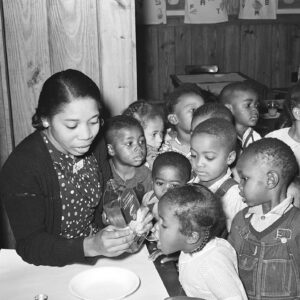 Lakeview Children
Lakeview Children 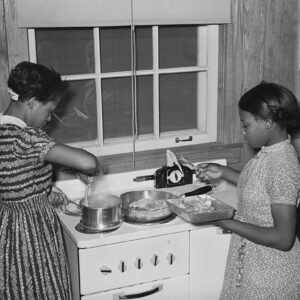 Lakeview Cooking Lesson
Lakeview Cooking Lesson 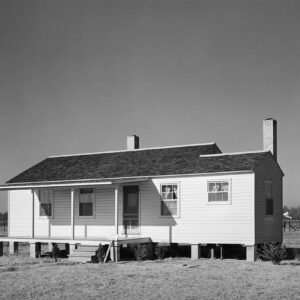 Lakeview House
Lakeview House 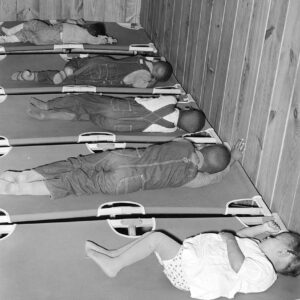 Lakeview Nursery
Lakeview Nursery 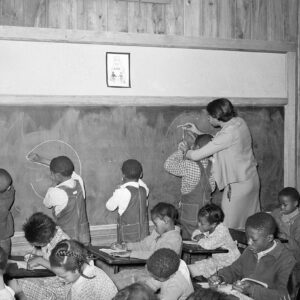 Lakeview Students
Lakeview Students 




Comments
No comments on this entry yet.